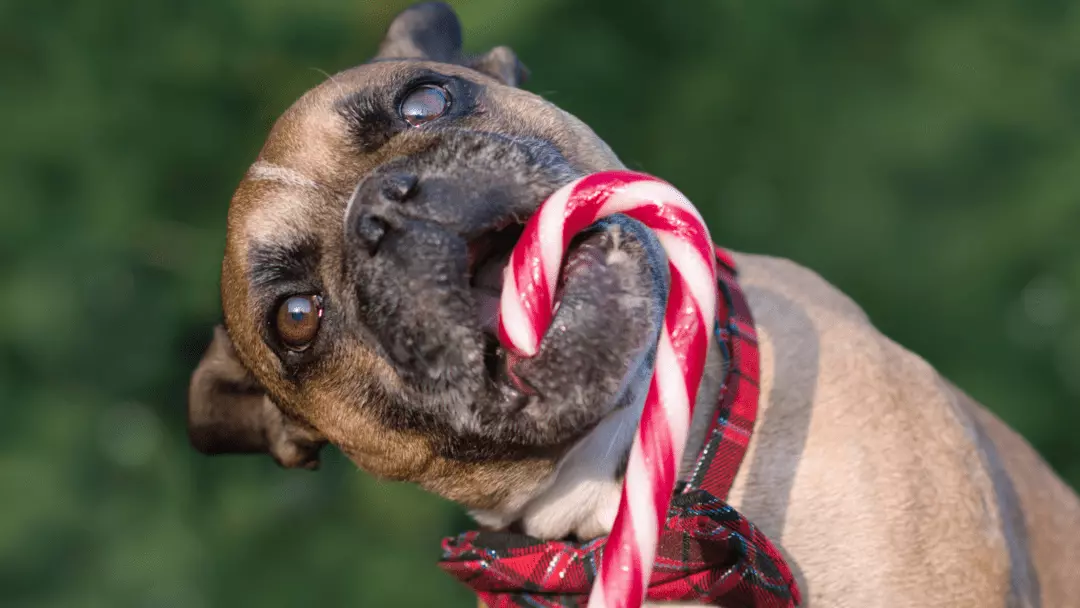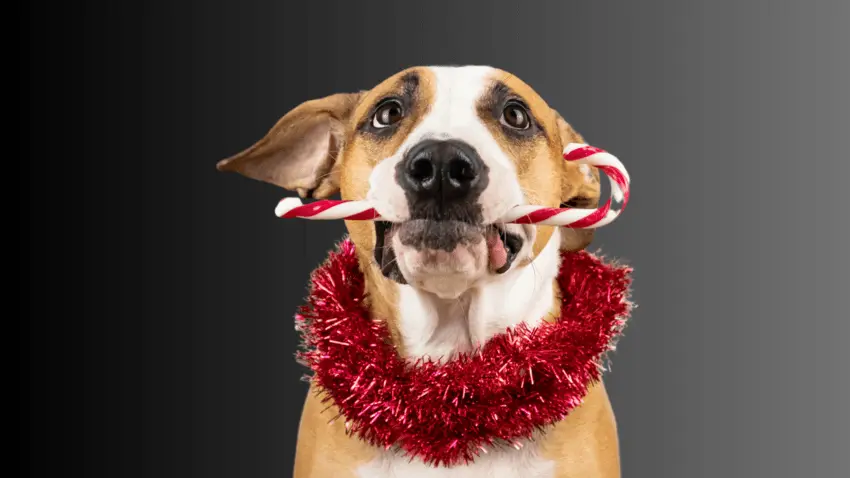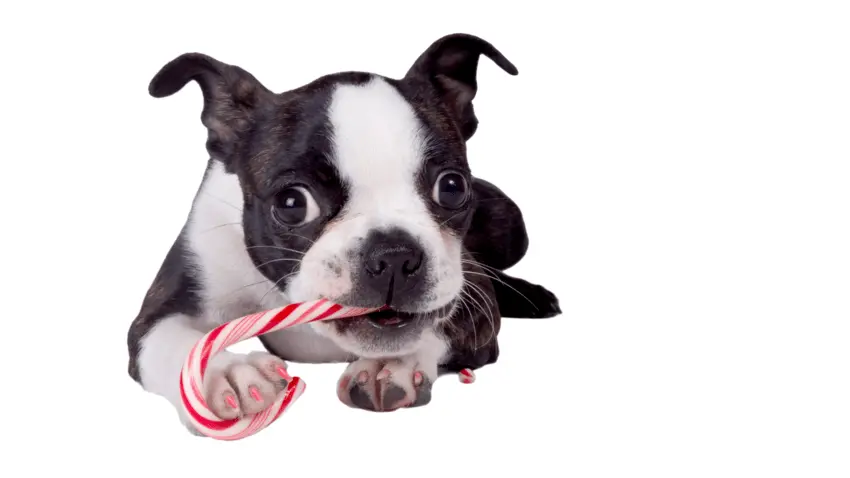What Should I Do If My Dog Ate Candy Cane?
With Christmas just around the corner, candy canes are already making their yearly comeback. But what should you do in case your dog ate candy cane?
Candy canes may seem like an innocent treat, but not for your dog. If eaten in large amounts, this sugary delight can kill a dog within hours. In this post, we discuss the dangers of candy canes and what you should do in case your dog raided your sweet stash.

Why are candy canes dangerous for dogs?

The following are the reasons why you should never give candy canes to your dog:
It contains xylitol
The main dangers of candy canes lie in its ingredients, specifically the xylitol content. Xylitol is a popular table sugar alternative due to its lower calorie content. It’s often found in desserts and sweets like candy canes.
Moreover, candy canes advertised to be sugar-free has the highest xylitol content. This is extremely toxic to canines because xylitol can trigger a rapid release of insulin, which will lead to hypoglycemia.
An unchecked case of canine hypoglycemia will cause liver failure. Overall, it only takes at least 0.05 grams of xylitol to cause toxicity among canines.
The onset of xylitol poisoning can occur within 30 minutes to one hour upon the ingestion of candy canes. If you suspect that your dog is experiencing xylitol poisoning, you should check for the following symptoms:
- Lack of coordination
- Vomiting
- Weakness
- Tremors
- Seizures
- Comatose
If your dog ate a candy cane and exhibits these symptoms, you should bring it to the vet right away. Take note that liver damage due to xylitol can happen in as fast as 18 hours.
Also, you should know that xylitol is also used on chewing gum products. If your dog ate gum, you should seek veterinary help as well.
It could have sharp splinters
Another risk of candy canes to dogs is their sharp edges. This candy can splinter, which can injure your dog’s tongue and gums.
Once ingested, the stiff candy cane can be like a sharp chicken bone. It can cause shallow cuts on the esophagus, stomach, and intestines of your pet.
If your dog ingests candy cane and proceeds to cough incessantly, there could be a candy sliver stuck on its throat. Bloating and straining to defecate are also signs that the piece of candy cane might be causing bowel blockages.
In this case, you should call the vet right away. Your dog may require an X-ray examination to see where the piece of the candy cane is lodged.
Your dog might eat the wrapper
Aside from the candy cane itself, the wrapper can also pose a risk to your dog. Candy canes are often wrapped in colorful plastics, which can block your dog’s intestines if ingested.
Most dogs can pass a plastic wrapper without problems. However, puppies and small breeds may find it hard to do so.When this happens, your little dog may experience vomiting, difficulty defecating, or not defecating at all. Unfortunately, you have to bring your pet to the veterinarian when this happens.
In some cases, the vet can induce vomiting, which can dislodge the plastic wrapper. However, if such a method doesn’t work, a surgical procedure might be necessary.
It’s packed with artificial flavors and colors
Lastly, candy canes are often packed with additives to make them visually appealing. Unfortunately, this ingredient will wreak havoc on your dog’s tummy together with the xylitol content.
Sure, the peppermint flavor can help freshen up your dog’s breath, but everything else in candy canes screams dangerous. Take note that candy canes are also available in other flavors, including chocolate that’s toxic to dogs (please read my article about what if my dog ate a chocolate pop tart).
As with chocolate, no amount of candy canes is safe for pets.
What should I do if my dog ate candy canes?

If your dog accidentally ate a candy cane, you should do the following:
Monitor your dog
Once you discover that your dog ate a candy cane, you should observe it for any adverse reactions. Most dogs will display symptoms of poisoning within two hours after the ingestion of the toxic substance.
If your dog exhibits any unusual symptoms or behavior, you must proceed to the next point.
Call the vet
Xylitol poisoning due to candy canes is a serious matter. It’s best to call your dog’s veterinarian even before the symptoms occur.
By being proactive, you can save your dog from the life-threatening effects of the toxic substance.
Make sure that you provide the veterinarian with crucial information, including the type of candy cane. You should also mention the time to which your dog ingested it and how much was consumed.
Through this, the vet can assess whether your pet requires emergency treatment or not.
If your dog’s condition worsens, the vet will administer IV fluids and liver protectants. Other drugs might be needed, depending on the candy cane ingredients your dog ingested.
Don’t feed your dog
Even if it’s time for your dog’s next meal, you should put it off until your pet is in the clear. Doing this will let you assess if the candy cane will trigger adverse reactions in your dog.
Take note that ingestion of new food would be detrimental if a sliver of the candy cane is stuck on your dog’s intestines or throat. And in the rare case of stomach perforation, the food may leak out and cause a slew of other health problems.
Tips to keep your dog safe during the holidays
The holiday season translates to lots of food and festivities. However, many of these food items aren’t safe for canines.
So to keep your pet safe from candy canes and similar items, here are a few suggestions:
Don’t display your candy canes
If your dog is highly food-driven, it’s not smart to hang candy canes. Your pet will find ways to reach it and eat the sweets.
Instead, you can use fake candy cane decorations. It still imbibes the spirit of Christmas minus the toxic xylitol that could harm your dog.
Inform the kids
During busy celebrations, it’s easy to lose track of your kids. This means your children may indulge in the candy canes and even share them with the dogs.
Before this happens, you must talk to your kids about the dangers of candies to dogs. I suggest putting up a special holiday treat jar for your dog, so your children won’t resort to giving candy canes.
Dispose of leftover candies wisely
Tossing leftover candy canes into an open trash can could turn into an expensive mistake at the vet’s clinic. If you have old candy canes to dispose of, you should place them inside double bags and into an enclosed garbage bin.
No matter how well-fed, dogs can turn into dumpster divers when bored. One thing you’d never want them to scavenge are sweet but expired candy canes.
Keep your dog away from the candy canes
If you’re keen to hang candy canes on the Christmas tree or fireplace, you should keep your dog away from it. Some pet owners even use wireless dog fences or scat mats to keep their pets off certain areas of the house.
However, the efficacy of this method depends on your dog’s tolerance level.
Conclusion
You have to act fast if your dog ate candy cane. The xylitol on these holiday treats is dangerous to canines, even in small amounts.
It’s best to call the veterinarian even before adverse symptoms occur. This will save your dog from the life-threatening effects, which can ensue within 12 hours.
